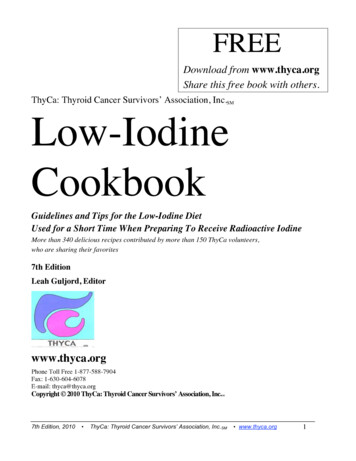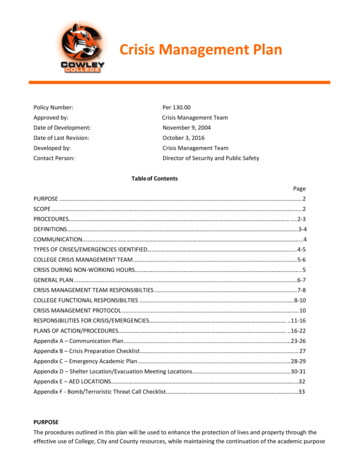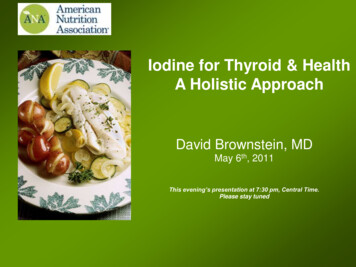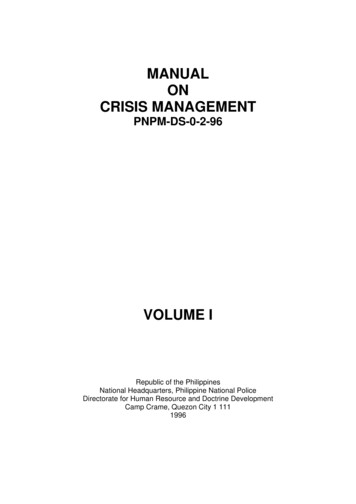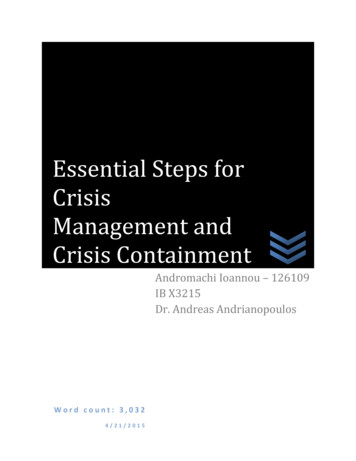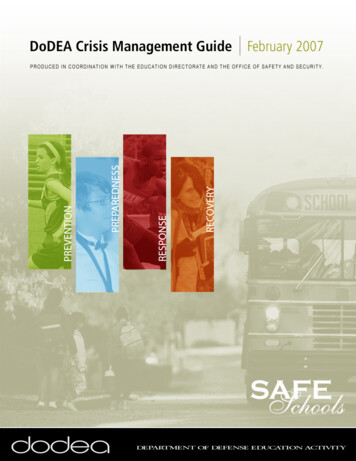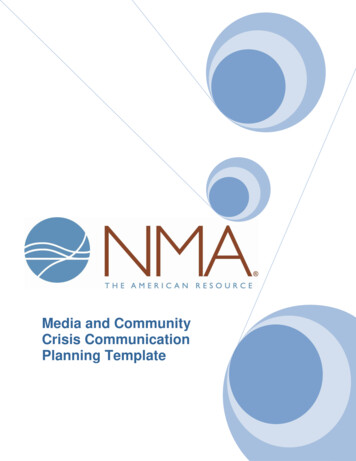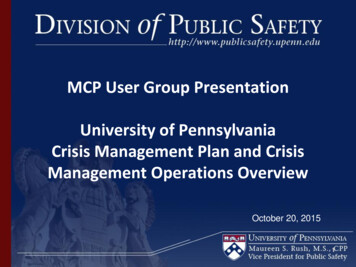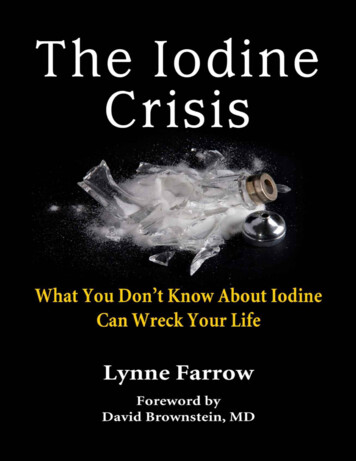
Transcription
Iodine the Health Solution for Many and Known by So Few Are you cold all the time? Are you always on a diet? Do you constantly gain weight or can’t takeit off, even when you drastically reduce calorie intake? Do you feel that your brain is scrambled—that you are in a “fog”?In your hands is the solution: the introduction of dietary iodine is proven to stop the progress of,and reverse, many illnesses—and it is a medicine that has been around for 15,000 years! Everybody knows certain environmental toxins cause cancer. What people don’t know is thesetoxins also make you “sick, fat and stupid.” The Iodine Crisis began when bromine useescalated over the last 30 years. Bromines deplete essential iodine. Where are bromines? They are everywhere: flour, fire-retardants, pesticides, certain foodsand sodas, drugs and personal care products. Is there a system for supplementing iodine? The Iodine Crisis reveals one that iodine takershave used since 2005. Think you get enough iodine in your salt? Are you sure? Iodine in iodized salt beginsevaporating as soon as the salt is opened, and is depleted over time—and the governmentRDA for iodine doesn’t make sense.Lynne Farrow reveals how she and thousands of other patient activists changed theirlives by researching and using iodine. The proof is in the case studies, many are sharedwithin.The Iodine Crisis: What You Don’t Know About Iodine Can Wreck Your Life
Truth has to be caught, not taught.The best preparation I’ve come across is an open mind from a deep desire to live fully, aninnate trust in ourselves or god or the universe to see the commonly unseen, to hear thecommonly unheard and know the commonly unknown that we may take action. Thispreparation blossoms with the camaraderie of like-minded individuals who share theirbest, knowing our paths are individual.—Sharon Williams Prahl
THE IODINE CRISIS:What You Don’t Know About Iodine Can Wreck Your LifeBy Lynne Farrow Copyright 2013 by Lynne Farrow. All rights reserved.No part of this book may be reproduced in any written, electronic, recording, or photocopying manner without written permission ofthe publisher or author. The exception would be in the case of brief quotations embodied in critical articles or reviews and pageswhere permission is specifically granted by the publisher or author.Although every precaution has been taken to verify the accuracy of the information contained herein, the author and publisherassume no responsibility for any errors or omissions. No liability is assumed for damages that may result from the use of informationcontained within.Books may be purchased by contacting the publisher and author at:Lynne@LynneFarrow.netCover Design: Nick Zelinger (NZ Graphics)Interior Design: Ronnie Moore (Westype Publishing Services, Inc.)Publisher: Devon PressEditor: John Maling (Editing By John)Manuscript and Cover Consultant: Judith Briles (The Book Shepherd)Printer: Color House GraphicsLibrary of Congress Catalog Number: 2012956255ISBN: 978-0-9860320-1-11. Iodine Deficiency. 2. Breast Cancer. 3. Health. 4. Nutrition. 5. Alternative Medicine. 6. Disease.FIRST EDITION 10 9 8 7 6 5 4 3 2 1Printed in USA
For Earl Foley
Table of ContentsAcknowledgmentsForewordIntroductionPart 1: Finding the Iodine Solution: My Journey1. Childhood Curiosity and Discovery2. Things Worse Than Brain Fog3. Breast Cancer Research Leads to Iodine4. Bromine and Iodine DeficiencyPart 2: FAQ—Frequently Asked Questions5. Why Does Your Body Need Iodine?6. Why Consider Supplementing Iodine?7. What Do Doctors Think About Iodine?8. How Often Should We Take Iodine?9. What Happens When Iodine Is Taken?10. What Are Side Effects of Taking Iodine?11. Where are the Iodine Online Discussion Groups?12. Why is Bromine Dangerous to Your Health?Part 3: Discovering the World’s Oldest Medicine13. Where Does Iodine Come From?14. The “Buried History” of Iodine15. The Magic Purple Haze—Iodine Emerges from the Ashes—Its Discovery
16. Who Stole Iodine from My Medicine?17. Who Stole Iodine from My Food?18. The Perfect Storm Theory of Breast Cancer19. Moving Forward—Beyond the Iodine CrisisPart 4: ResourcesThe Iodine Loading TestIodine Supplementation ProtocolLugol’s Iodine Solution Chart: Milligrams of Iodine per DropThe Salt Loading ProtocolIodine-Related Bromide and Toxin Detoxification Symptoms and StrategiesAppendix A: The Bromide Dominance TheoryAppendix B: Iodine and the BreastAppendix C: Bromine-Bromide Products which Compete with IodineAppendix D: Fluoride in Pharmaceuticals which Compete with IodineIodine GlossaryAdditional References and ResourcesWhere to Find Iodine SupplementsIndexAbout the AuthorWorking with the Author
AcknowledgmentsWhen investigating a complex subject, an author meets many people who offer leads andinformation. You never know where you will end up or who will help. You never knowwhat burning questions the detective work will raise as the mystery deepens. More than once, Iasked myself, how did I get here? Why am I reading about iodine and syphilis in the 1800s? Whydid I just buy a Civil War iodine canteen from eBay? How can this information ever help peoplein the present day? Who cares about iodine anyway? Fortunately, the global village that is theiodine online community cares and has created a bounty of resources that keeps growing. Thereare many to thank.The Iodine Project founded by the pioneering work of Guy E. Abraham, MD, DavidBrownstein, MD, and Jorge Flechas, MD, created the touchstone for the iodine research whichfollowed. I and others express our profound indebtedness to these physicians for not onlyrevolutionary thinking but for transforming so many people’s lives. The legacy lives on. I hopethis book will exist as just one of many which examine the Iodine Project’s significance tomedical history.Lucky for me, many other non-doctors shared my enthusiasm for chasing down the questions:Where did Iodine come from? Why did it disappear? How can we revive the information of TheGolden Age of Iodine? We call this obsession The Abraham Effect because Dr. Guy Abraham, thefather of the Iodine Movement, infected us with the incurable curiosity about iodine.I’m indebted to many who inspired and supported my effort to write The Iodine Crisis. Thebook could not exist without the curiosity and research expertise of the online iodine groups: TheCurezone Iodine Forum moderated by Steve “Trapper” Wilson, Laura Olsson and Chris C.Vulcanel, and the Yahoo Iodine Group founded by Iodine pioneer Zoe Alexander, now owned byDr. Stephanie Buist and moderated by Victoria Baker, Kathleen Blake, Donna Iler and LinnMiller. Fred Van, thank you for your help in spreading the iodine information, gathering resourcesand compiling iodine stories.Patient-to-patient experts Janie Bowthorpe, Sandra Anderson and Deb Anderson Eastmanhave left me an exemplary body of written work which I learn from everyday.I would like to acknowledge our team at Breast Cancer Think Tank, the online discussiongroup of Breast Cancer Choices which provided so much information, experimentation andkindness during the years we have been exploring iodine. Thank you, Sally Gould, for your workhelping with the website and research at www.BreastCancerChoices.org.A big thank you to those who read the manuscript and offered their inspired criticism and
suggestions. David Brownstein, MD, Kathleen Blake, Victoria Baker, Laura Olsson, Steve“Trapper” Wilson and Robin Stamm. I hope I captured the precious offerings you gave me. If not,any mistakes that remain are mine alone.Lynn Razaitis, my friend and long time Iodinista, thank you for your wise guidance on the bookfrom start to finish. I look forward to working with you on www.IodineResearch.com. Thank youfor helping make sure the legacy of iodine will never get lost again.Earl Foley and Ginny Kubler, thank you for your wise counsel and patience. You know howmuch of yourselves ended up on the pages. Gerry Simons, PA, thank you for your expertise as ourlocal Iodine Literate Practitioner. Your brilliance and kindness turned the most challenging oftimes into a blessing.Thank you to organizations such as Weston A. Price Foundation, The American College forAdvancement in Medicine, The Cancer Control Society and The American Academy of AntiAging Medicine for getting the iodine message out there early. A special acknowledgement to AnnFonfa and the mother ship of patient-to-patient cancer information, The Annie Appleseed Projectwhich has been committed to reporting iodine information since the beginning. Mary Mucci ofLong Island Naturally, the New York area owes you an award for breaking the Iodine Crisis andother stories on your show. To my friends at the Amagansett Library, I am in your debt.Lastly, but most importantly, I’m honored by the many people who offered their iodine successstories to this book. You changed my life. You will change the lives of those who read yourheartfelt words. The legacy of your stories lives on.
ForewordThe Iodine Crises: What You Don’t Know About Iodine Can Wreck Your Life is a much neededbook. Lynne Farrow has written an easy-to-read book that will help many who suffer fromcommon medical ailments including fatigue, brain fog, thyroid disorders and breast disease. Ms.Farrow’s description of the benefits of iodine therapy makes for compelling reading.Furthermore, this book describes the long history of iodine usage in medicine and why iodine hasfallen out of favor with conventional medicine.Lynne describes her own journey from becoming ill to obtaining good health. After a myriadof complaints, she was diagnosed with breast cancer. She gives her first-hand account of herexperiences with oncologists and other doctors. Lynne was not satisfied with the information herconventional doctors were providing her. They could not answer her questions about why theirrecommended treatment plan would be the best option for her. Being a journalist, Lynne did herown research into breast cancer and found that iodine deficiency may be a big missing link intowhy so many women are being diagnosed with cancer. This book describes that journey andpresents the information about iodine and breast cancer that anyone can understand.There is a plethora of research relating iodine deficiency to breast diseases including breastcancer. In fact, the research dates back well over 70 years. Yet, conventional medicine is stuck intheir model of surgery, chemotherapy, hormonal therapy, and radiation, all of which have donealmost nothing to change the course of the illness in over 70 years. In fact, the only thing changingover the last 70 years is that more and more women—nearly 1 in 7—are being diagnosed withbreast cancer. After finding the research relating iodine deficiency to breast cancer, Lynne tookmatters into her own hands and started supplementing with iodine. She immediately felt better andhad many positive health benefits which she describes in the book. After this experience, Lynnewas off to the races and began her quest to inform people about iodine. This path led her to foundBreast Cancer Choices, Inc., which I have referred many patients to.The most striking part of this book are the numerous case studies. From fatigue to psoriasis,headaches and cancer, people have sent Lynne their personal story about how iodine therapyimproved their health. Many of the stories may seem unbelievable. However, they are not to me. Ihave been prescribing iodine for well over 10 years. I hear similar stories from my patients on adaily basis.Unfortunately, for most patients their doctor has no knowledge about iodine therapy. In fact,most doctors think iodine is a dangerous substance that should be avoided. I should know. I havebeen writing and lecturing to doctors for years about the benefits of iodine. I can assure you that it
is difficult to get a doctor interested in iodine therapy. They don’t seem to understand that iodineis an essential ingredient—that life itself is not possible without adequate iodine levels.Over the last 40 years, iodine levels have declined over 50 percent. The consequences of thisdecline are severe—including epidemic increases in illnesses of the breast, thyroid, ovaries,uterus, and prostate. Unless conventional medicine devotes its vast resources to searching forunderlying causes of these illnesses we will continue to see suboptimal results with theirtherapies. Conventional medicine has truly failed us all in its lack of concern for what is actuallycusing this epidemic rise in illness. It continues to be stuck in a diagnostic and treatment mode.Ultimately, we will not make consistent and definitive progress against these illnesses unless weunderstand what the underlying causes behind them are. I feel the large increase in chronicillnesses could be explained by deficiencies of essential nutrients, hormonal imbalances, and anincreased exposure to toxic elements.The resources section of this book tells you how to test for iodine deficiency and how toavoid problems when taking iodine. I hear complaints from some of my colleagues that iodinecauses side effects. They are right—anything, iodine therapy included, can cause adverse effects.However, the correct use of iodine is not associated with too many adverse effects. Theinformation that Lynne has written in The Iodine Crisis can teach you how to minimize sideeffects with iodine. These are the same steps I recommend to my patients.I believe this book should be on every bookshelf. The information found in it can help you andyour family avoid a preventable health problem. I highly recommend this book to anyoneinterested in improving their health.—David Brownstein, M.D.www.DrBrownstein.comAuthor of 11 books including:Iodine: Why You Need It, Why You Can’t Live Without ItOvercoming Thyroid DisordersSalt Your Way to Health
IntroductionEverybody thinks they know what iodine is. Everybody’s wrong.—Earl FoleyIodine deficiency wrecked my life. For years I endured headaches with brain fog so bad that Ilost my driver’s license for speeding through stop signs. I slept so much my family called meRip Van Winkle, and I could no longer work full time, even with caffeine and painkillers. I wentfrom teaching college full time to working as a journalist part time. I grew overweight from anundiagnosed thyroid disorder and finally, when I thought my life couldn’t get worse, I wasdiagnosed with a life threatening disease.By some turn of fate, Iodine came into my life at just the right time. Dr. Sherri Tenpenny, adoctor I ran into casually at a medical conference, mentioned iodine for fibrocystic breastdisease. I was intrigued but skeptical. After all, iodine? Surely, she didn’t mean that brownantiseptic bottle in the medicine chest? What was iodine anyway? Didn’t we get enough iodinefrom iodized salt?Here’s where the medical detective story starts. I decided to research iodine in the mostconservative way; I started with the bounty of medical studies buried in the National Library ofMedicine. Then, I ratcheted up the investigation and hunted down old and out-of-print medicalbooks. I acquired antique iodine products from eBay, some with the instructions still intact. Whena pharmacist’s ledger, dated 1901, went to auction, I snapped it up. Sure enough, it was filledwith countless iodine prescriptions. Records of iodine medicine stretched around the globe, goingback a hundred and fifty years as a “universal medicine,” and further—15,000 years—in itsearlier form as seaweed. Archaeology records documented how prehistoric peoples hoardedcertain seaweeds. In hopes of solving the mystery, I began creating an Iodine Timeline to recreatethe series of events leading up to the time iodine vanished from common use. My intention was torecreate events leading up to the disappearance of iodine.Why didn’t somebody speak up when iodine suddenly went missing from the medical arsenal?The plot thickened when I discovered iodine was called “dangerous” by a research duo in 1948.Their opinion was contradicted by all the previous years when iodine was used liberally foreverything from syphilis to breast cancer. No matter. Somehow iodine’s historic benefits weresuddenly snatched from the medical text books and largely banned from human research. Why?Who stole iodine?
Why did iodine-fortified bread also disappear in the 1970s? Could something in ourenvironment be working to purge iodine? Why do people excrete half as much iodine in theirurine now than 40 years ago? Is there a conspiracy here or just goofy negligence? While I wassleuthing the mystery of who stole iodine, I concluded I’d researched enough to determine thatiodine was safe to consume in larger doses than the government-published daily requirement.One morning I started the day by swallowing 50 mg of Lugol’s iodine tablets. Boing! Mybrain came to life. Brain fog vanished. In the months that followed, all the other conditionsplaguing me disappeared. My energy improved and my weight normalized. I was no longer socold I needed to wear two pair of socks. Even superficial things improved. I used to slather mydry hands with hand lotion, day and night. Now, I can’t imagine why my hands ever needed extramoisture. The iodine experience seemed too good to be true. If iodine was so great, why didn’teverybody know about it?How could one cheap nutrient reverse so many conditions? How did I get so iodine deficientanyway? I had always eaten seafood and iodized salt. What happened to the iodine in my food?Where was it going?Then I discovered the newly minted Iodine Project founded by pioneer iodine doctors,Abraham, Brownstein and Flechas. Here was the mother lode of iodine detective work! Thedoctors were already on the case of iodine deficiency and had been quietly and carefully pilingup documentation. On the internet, the first iodine experimenters started to appear. More doctorsfamiliarized themselves with iodine and tried it themselves. Online groups formed to discuss andinvestigate taking iodine.So many people reported benefits and swapped information that we tried to publishFrequently Asked Questions to lay out the information. We created online resources to help thosenew to iodine.Predictably, skepticism reared its ugly head with online hecklers predicting that, since iodinewas a “poison,” soon we would all die. Some reported temporary side-effects, but no one couldargue with success stories and the reversal of profound medical complaints. How many othershad iodine supplementation helped? When more and more websites and doctors began to reportthe benefits of iodine, we began to realize a grass roots movement had emerged challenging thecurrent theory that iodine was toxic.My detective work uncovered evidence iodine had been used in one form or another for15,000 years. The long medical anthropology of iodine validated its effectiveness. Iodine wasn’talternative medicine, it was traditional medicine that had been lost.The plot thickened again when I discovered the anti-iodine element, bromine, was added toflour at the same time iodine was removed—in the 1970s. Iodine disappeared just as brominescame charging in. Besides bread and flour, bromine chemicals became an environmental hazardas they were added to mattresses, foods and other consumer products, purging much of our dietaryiodine.So what do we have? A perfect storm for an iodine deficiency crisis. How did the perfectstorm scenario manifest? For starters, thyroid and breast disease skyrocketed between 1970 and2000. Lower iodine levels means IQ levels dropping and obesity rates rising. The iodine crisismade us sick, fat and stupid. Think this conclusion is theoretical? Ask the people besides myself
who were all three—sick, fat and stupid. Many of their stories populate this book.The stories show exactly how people have benefited from iodine, whether it’s a little or a lot.History tells us when you let people speak in their own words, a revolution begins. Thus, themany first-hand iodine reports carry the message better than any second-hand description could.Read them. The personal stories will touch your heart.In my role as director of a nonprofit that investigates iodine as a healing strategy, I get emailsfrom all over the world with stories about iodine. Wendy Farrow (no relation) from Canada, apatient in the 1980s of the late iodine investigator, Dr. W.R. Ghent, discovered our website andwe were able to put together lost stories. A Russian immigrant even contacted me about howiodine was inhaled in Russia to keep germs from respiratory tracts when travelling. People emailme before-and-after photographs, thermograms and mammogram films. The success stories keeppiling up.We can’t let the stories of the Iodine Movement and its founders be lost to the vapors ofhistory. Someone had to write about how the movement started and how it changed the way wethink about arbitrary medical consensus. I’ve done my best to piece together who did what andwhen. When Dr. Guy Abraham launched the Iodine Movement, he was unaware of thesignificance of his feat. Many of us who were the beneficiaries of his revolutionary thinking,believe the Nobel Prize is not good enough for him. But we are willing to settle.Lastly, The Iodine Crisis was written because those interested in iodine need a place to findthe frequently asked questions and the answers that have developed over the years. The IodineCrisis: What You Don’t Know About Iodine Can Wreck Your Life serves as a patient-to-patientguide—lessons learned on the barricades. The information contained in the book makes nopretense of being medical advice. Please take the reporting in the journalistic spirit with which itis intended. Spread the word. Lend this book to your doctor. Let’s continue to learn from eachother.
Part 1Finding the Iodine Solution—My Journey
Chapter OneChildhood Curiosity and DiscoveryStudy hard what interests you the most in the most undisciplined,irreverent and original manner possible.—Richard P. FeynmanWhen I was ten months old, my parents rented a bungalow at the New Jersey shore. Theyset me on the sand and gave me a yellow plastic shovel.“Dig,” they said.That was all I needed to stay transfixed for over an hour, digging in the sand, looking at thewaves roll in, watching the water mysteriously sink into the sand as streaks of plant life piled upand sand crabs scurried. I remained so entranced that my parents later told me they worried Imight be “slow.” Every year we came back for two weeks and each year I grew more curious asmy little legs carried me farther. Eventually they gave me a yellow pail for collecting my finds.In New Jersey, we don’t call the seashore “the beach.” It’s called the “shore” as in “let’s godown to the shore.” This is because the shore is more than the beach of crashing waves andsuntanned bathers. The shore is a terrestrial wonderland with the bays and inlets wandering intocurious backwaters. Follow a stream of salt water and you find tide pools and salt marshes filledwith birds and plant life so ornate, humans could not imagine them without seeing them first hand.With my magic yellow pail and shovel, the earth opened up to me.When I grew a few years older, going for a walk at the shore meant I never knew where todirect my eyes. What was the embarrassment of gifts deposited at my feet? The bird eggs, theseaweeds in more shades of green than I had ever seen, the intricate seashells and edible musselstangled in sea lettuce. Why did some seaweed look like red hair? I still remember what beingclose to the ground felt like, examining each bit of sea-driven mystery in my hand.“You mean I can keep this shell?” I asked. “Can I take the seaweed home?” How could anyobject so precious and magical be free or just left out in nature for the taking? Looking ceasedbeing enough. My father started turning over what we found along the beach. When he turned overshells, sand crabs would scurry. He would turn over rocks and find cases of eggs.“The Indians ate these,” my father said, when I dug up a clam.
“You can eat that,” he said when we found bladderwrack seaweed. “Lots ofvitamins.”I learned an important lesson from this second step of exploring: you didn’t needto restrict yourself to looking, then moving on. You could turn over shells, look underrocks. Active participants can learn more than mere observers.My parents encouraged my curiosity and bought me a small Golden Book titled Seashoreswhich I memorized without realizing it because I couldn’t stop looking at the pictures. From thetitle I learned that the “things” I brought home from the shore weren’t just things, but a vast systemof living beings. Where did all these shells and seaweeds come from? How did they fit together?The book taught me that a curiosity needn’t be idle or instant, that it could take you on a longjourney and open up far-ranging worlds. If it were possible to radiocarbon date the beginning ofmy love affair with curiosity, I would write the date my parents put Seashores in my hand. Littledid I know that my childhood love and obsession would lead to my eventual success in pursuingthe iodine mystery.Childhood “Training” Pays Off—Curiosity Did Not Kill the CatFast forward several decades.As a grown-up, my obsession with all things marine persists, but I could never predict achildhood of sand-digging would reinvent itself decades later in a mission to learn about iodine.Learning about anything always puzzled me. I never knew the right way to learn, so I just wadedin and tried to connect the dots. This served me well in my academic and journalism careerswhere I discovered a learnable process called “fact checking”—finding the sources ofinformation.Wise mentors schooled me in how to ask better questions and how to push forwardfurther to ask questions of questions.Asking, “What’s the source and function of this information?” became a skill I honed, a habit,even a reflex. These skills served me well. That is, until I lost them.As a young adult, I was not well, and in my thirties I began to feel worse and worse.Headaches which had been a problem since my twenties suddenly became an everydayoccurrence. I went to a series of headache clinics around the US. A series of other diagnosescame in: hypoglycemia, adrenal weakness, hypothyroidism, chronic fatigue, candida, multiplechemical sensitivities, ovarian cysts, fibrocystic breast disease. I put on extra weight. I felt coldall the time and was a challenge to live with because I was always hungry or looking for my vialof Darvocet.The chronic, mysterious complaints became very isolating to me because all my family
members and friends seemed healthy. But in the various doctor’s offices I visited, I met a lot ofpeople like me. Their individual complaints may have been arranged in a different order ofpriority, but there were a lot of sick people out there searching and not getting results. Some verycandid doctors said they didn’t know how to treat us. Although they meant well, I grew frustratedwith them. On TV, every illness came with a dramatic diagnosis and instant cure. Why couldn’tthese doctors find the answer for me? How many patients were out there coping, day-to-day, withno hope in sight?Meanwhile, I tried to impersonate a healthy person, both socially and in business. Here wasthe stop-gap solution. I only picked jobs where I could control the amount of time I spent inpublic. My full-time college teaching job only required three days a week, but even that provedtoo intense with the requirement of being “on” to give lectures and then work one-on-one withstudents. I would come home and fall asleep at six o’clock. My family called me Rip Van Winkle.Anyone who has chronic illness will understand you lead a secret life, arranging your businesshours around rest opportunities and finding excuses for missing weddings or other social events.When I was working as a journalist, an editor phoned, offering me a lucrative writingassignment that required flying to London to cover a major two-day media event. I was tooembarrassed to say crossing the Atlantic twice in three days would exhaust me for weeks. So Ichirped, “sure” into the phone before I realized what I had gotten myself into.There would be endless standing around and walking. Sensible shoes wouldn’t cut it. Howwould I endure standing on my feet for two days? Could I fortify myself with Darvocet for theheadaches and caffeine to keep me going? That was as far as I got with the plan. The next night,standing in the departure line at Virgin Airlines, I began counting the hours until I would be backhome, lying on my own living room couch.My first day in London, I woke up in the hotel room, walked into the bathroom and promptlybroke my toe by stubbing it on the toilet. I saw stars from the pain. Alone, lying on the bathroomfloor, nausea swept over me for ten minutes until I composed myself. The hotel called a doctorwho bandaged me up and ordered, “Stay off your feet.”But the temporary physical setback provided surprising advantages. When I went to pressgatherings, I was given preference. Walking around with a big, bandaged toe meant I got to sitwhile the other reporters had to stand. The sore toe gave me an adrenalin surge and made mefeisty. When I shouted out questions at the press conference, I always got answers while the burlyand pushy types were ignored. One reporter resented this and complained that “Toe Girl” wasgetting more questions answered than any of the others. My big bandaged toe had turned what Ithought would be a sow’s ear into a silk purse.Brain Fog AlertA few years later, I complained to several doctors that I felt “underwater.” The doctors called thiscondition “brain fog.” One doctor told me, “There are things worse than brain fog.” Easy for himto say. This frustrating mental impairment was worse than the headaches or fatigue, becausethinking was the only thing I had been trained to do. I used to be able to think privately betweennaps. If I
iodine online community cares and has created a bounty of resources that keeps growing. There are many to thank. The Iodine Project founded by the pioneering work of Guy E. Abraham, MD, David Brow

